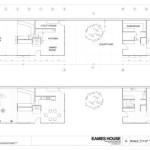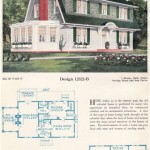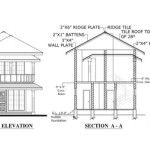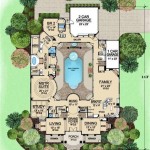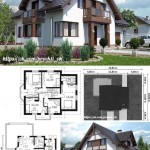Old Victorian House Plans: A Journey Through Architectural History
Victorian architecture, spanning the reign of Queen Victoria from 1837 to 1901, encompasses a diverse range of styles reflecting the era's rapid social and technological changes. Old Victorian house plans offer a fascinating glimpse into the domestic lives of the period and continue to captivate homeowners with their intricate details and romantic appeal. This article explores the key characteristics and variations found within Victorian-era house plans.
Key Characteristics of Victorian House Plans
Several defining features distinguish Victorian house plans from other architectural styles:
- Complex Rooflines: Steeply pitched roofs, often adorned with gables, dormers, and turrets, create a dramatic silhouette.
- Ornamental Details: Decorative trim, gingerbread woodwork, brackets, and cornices add richness and visual interest to the exterior.
- Bay Windows: Projecting bay windows, often multi-sided, enhance natural light and provide panoramic views.
- Wraparound Porches: Spacious porches, sometimes wrapping around multiple sides of the house, offer outdoor living space and enhance curb appeal.
- Asymmetrical Facades: Unlike earlier architectural styles, Victorian houses often feature asymmetrical facades, adding to their dynamic character.
- Stained Glass: Decorative stained-glass windows, particularly in entryways and stairwells, add color and artistry.
- High Ceilings: Generous ceiling heights contribute to a sense of grandeur and spaciousness.
Popular Victorian House Styles
The Victorian era witnessed the evolution of several distinct architectural styles, each with unique characteristics reflected in their floor plans:
Gothic Revival
Inspired by medieval Gothic architecture, Gothic Revival houses feature pointed arches, steeply pitched roofs, decorative bargeboards, and often, a central tower or turret. Floor plans tend to be irregular, with interconnected rooms and dramatic vertical spaces.
Italianate
Italianate houses draw inspiration from Italian Renaissance villas. Characterized by low-pitched roofs, wide overhanging eaves with decorative brackets, tall, narrow windows, and often, a square tower, these homes typically have symmetrical floor plans with clearly defined rooms.
Queen Anne
Perhaps the most recognizable Victorian style, Queen Anne houses are known for their asymmetrical designs, intricate ornamentation, towers, turrets, and wraparound porches. Floor plans are often complex, incorporating a variety of room sizes and shapes.
Second Empire
Distinguished by their mansard roofs, Second Empire houses exude a sense of grandeur. Dormers punctuate the sloping roofline, and decorative elements such as cornices and quoins add to the opulent aesthetic. Floor plans typically feature a central hallway with rooms branching off on either side.
Stick Style
Emphasizing linear elements, Stick Style houses feature decorative "stickwork" on the exterior walls, often mimicking half-timbering. Gable roofs, overhanging eaves, and porches are common features. Floor plans tend to be relatively simple and open.
Folk Victorian
A simpler, more vernacular interpretation of Victorian architecture, Folk Victorian houses often incorporate elements from various styles. Decorative trim, gables, and porches are common, but ornamentation is generally less elaborate than in high-style Victorian homes. Floor plans are often adapted to regional building practices and available materials.
Eastlake
Known for its intricate, geometrically patterned woodwork, Eastlake style emphasizes surface decoration. Turned spindles, brackets, and latticework adorn porches, gables, and other exterior elements. Floor plans often resemble those of other Victorian styles, with the distinctive Eastlake ornamentation setting them apart.
Shingle Style
Popular in coastal areas, Shingle Style houses are characterized by their use of shingle cladding, often covering the entire exterior. Gamble roofs, large porches, and asymmetrical designs are typical. Floor plans often emphasize open, flowing spaces and connections to the outdoors.
Richardson Romanesque
Inspired by Romanesque architecture, Richardson Romanesque houses feature heavy masonry construction, rounded arches, and towers. Floor plans are typically grand in scale, with spacious rooms and high ceilings.
Considerations for Using Old Victorian House Plans
Adapting old Victorian house plans for modern living requires careful consideration:
- Modern Amenities: Integrating modern plumbing, electrical systems, and HVAC into an older structure requires careful planning and execution.
- Energy Efficiency: Older homes may lack insulation and other energy-saving features. Retrofitting for improved energy efficiency is essential.
- Structural Integrity: Assessing the structural soundness of an older home is crucial before undertaking renovations.
- Local Building Codes: Renovations must comply with current building codes, which may necessitate modifications to the original plans.
- Historic Preservation: If the house is located in a historic district, renovations may be subject to review and approval by a historic preservation commission.
Old Victorian house plans offer a wealth of inspiration for homeowners seeking a unique and historically rich dwelling. Understanding the defining characteristics and variations within Victorian architecture allows for informed decisions when choosing and adapting these plans for modern living.

Vintage Victorian House Plans 1879 Print Plainfield George La Baw Floor Mansion Plan

House Plans Victorian Vintage Sims

Untitled Victorian House Plans Mansion Floor Plan Homes

The Glen Flora Victorian House Plans Old Vintage

29 Victorian House Plans E Book Vintage

House Plan 73837 Victorian Style With 4200 Sq Ft 2 Bed Bath

Victorian House Plans Floor The Designers

Modern Cottages J H Kirby Architect Victorian House Plans Vintage

Plans For A Country Villa Circa 1875 Old House Web

1905 Hodgson House Plans Early 20th Century Homes Old Houses For



